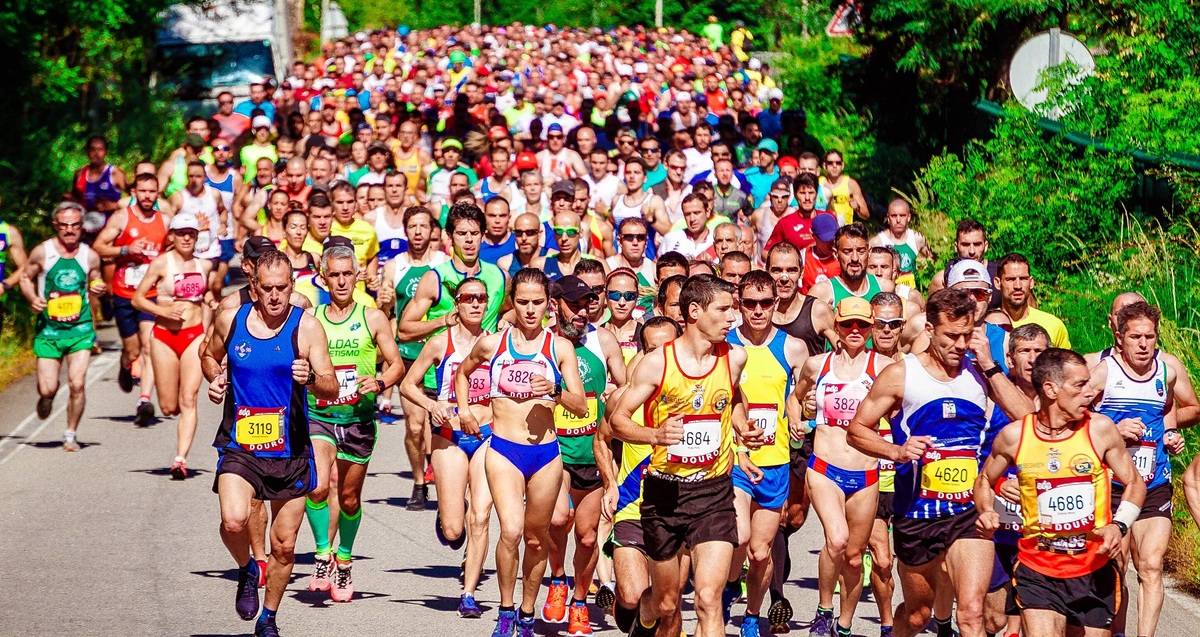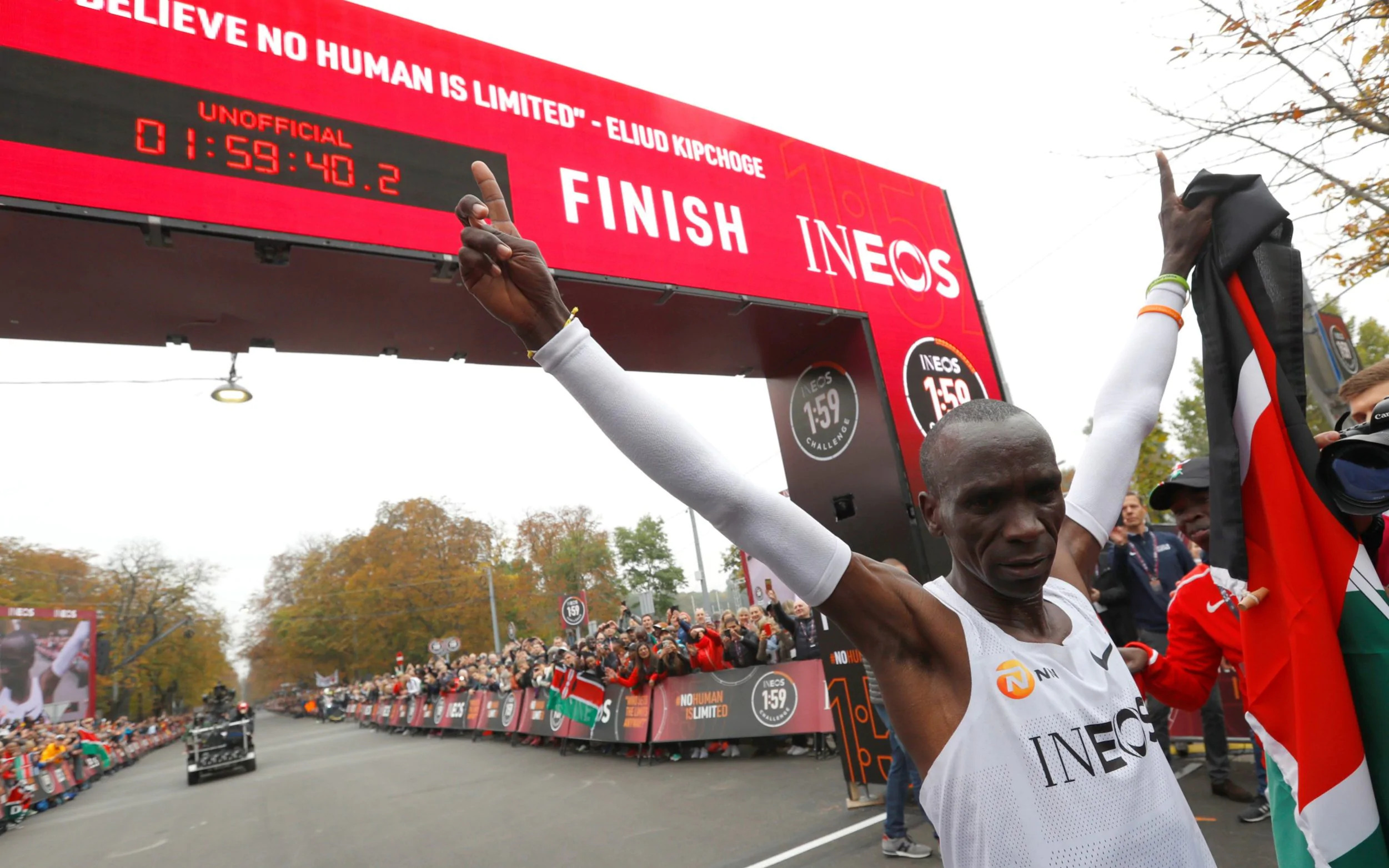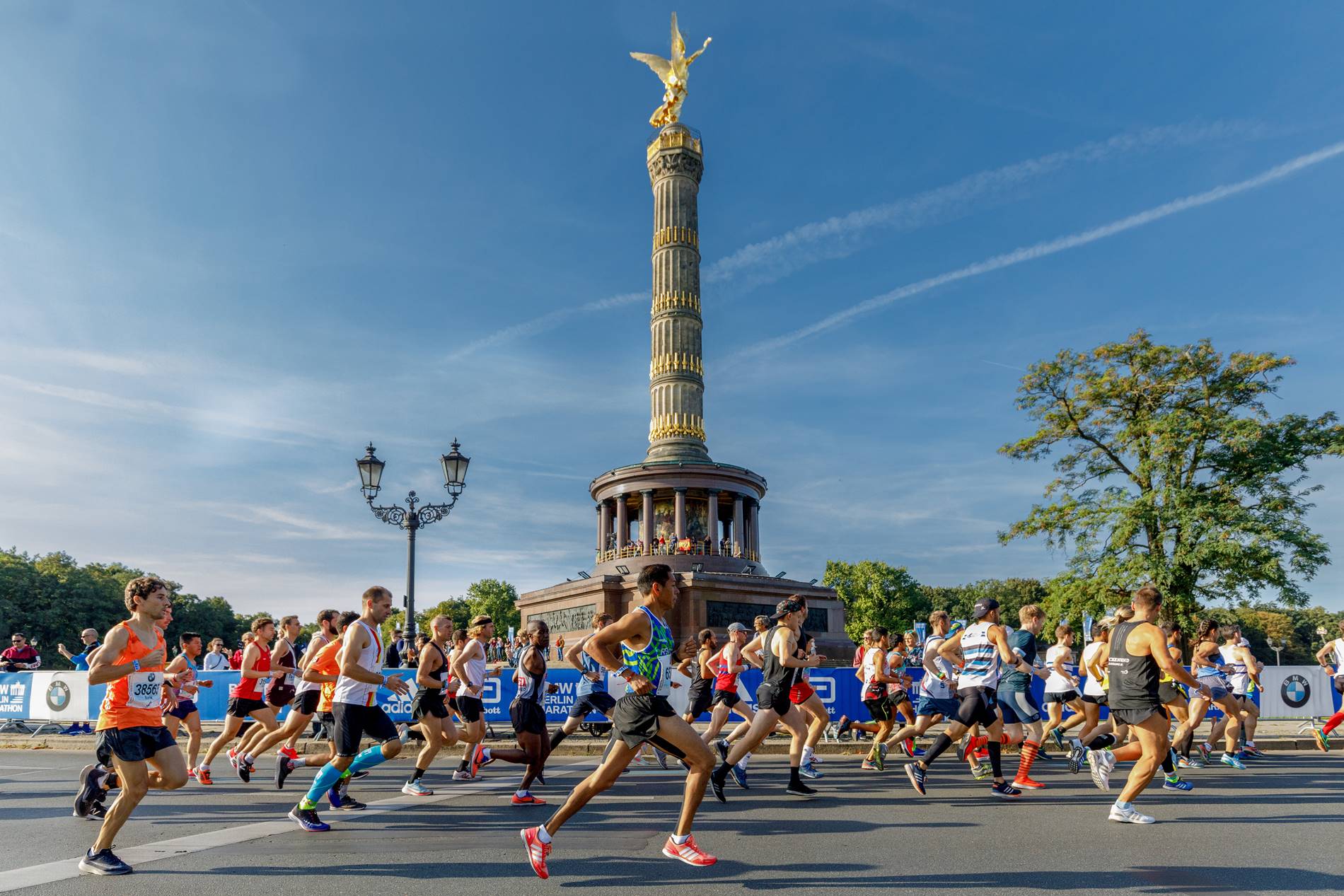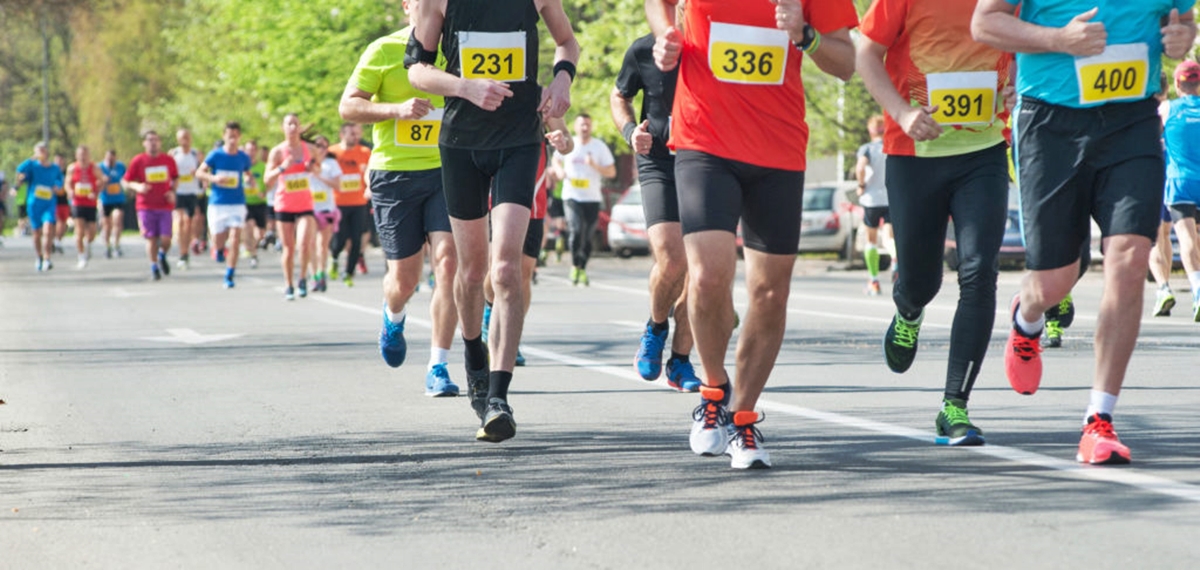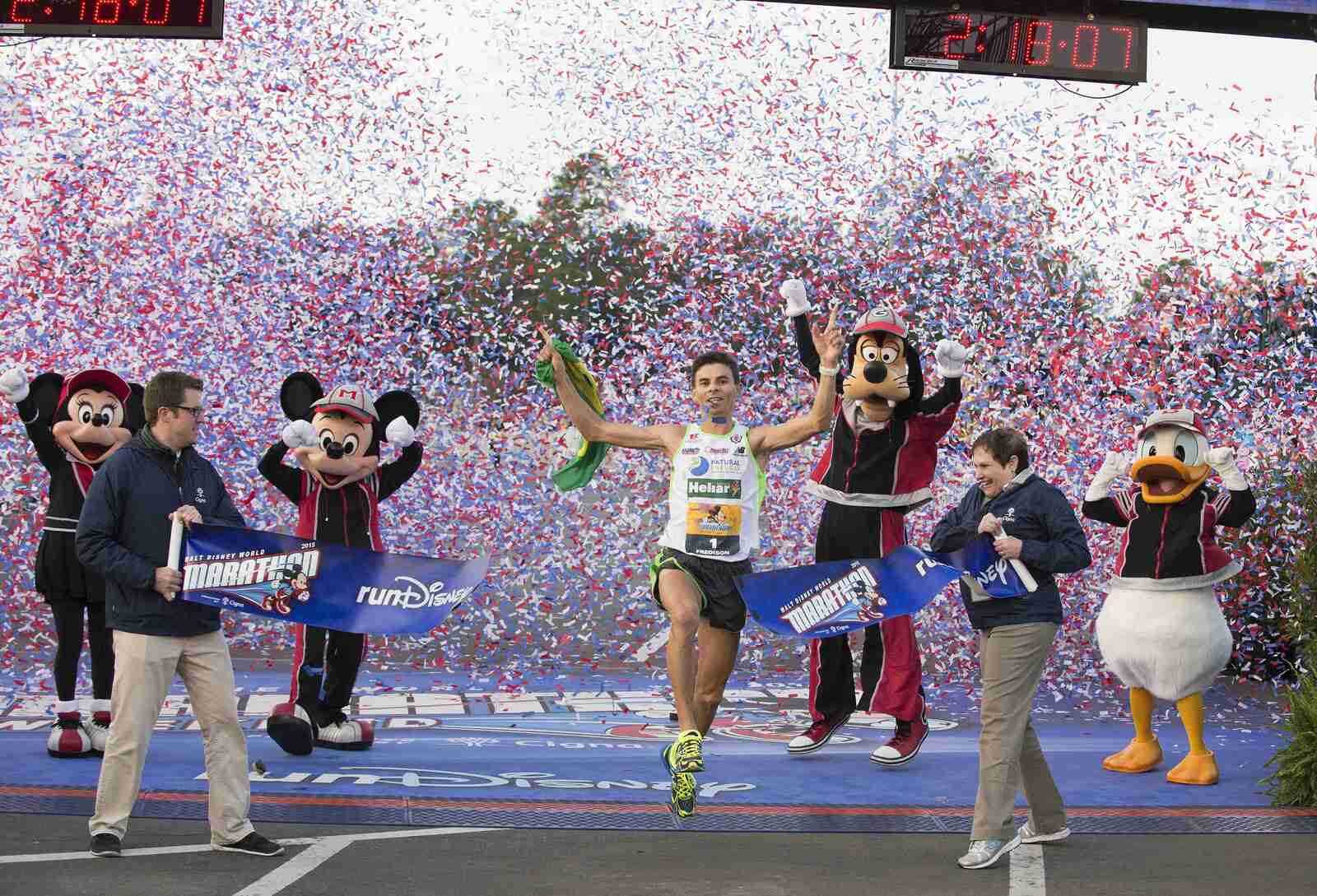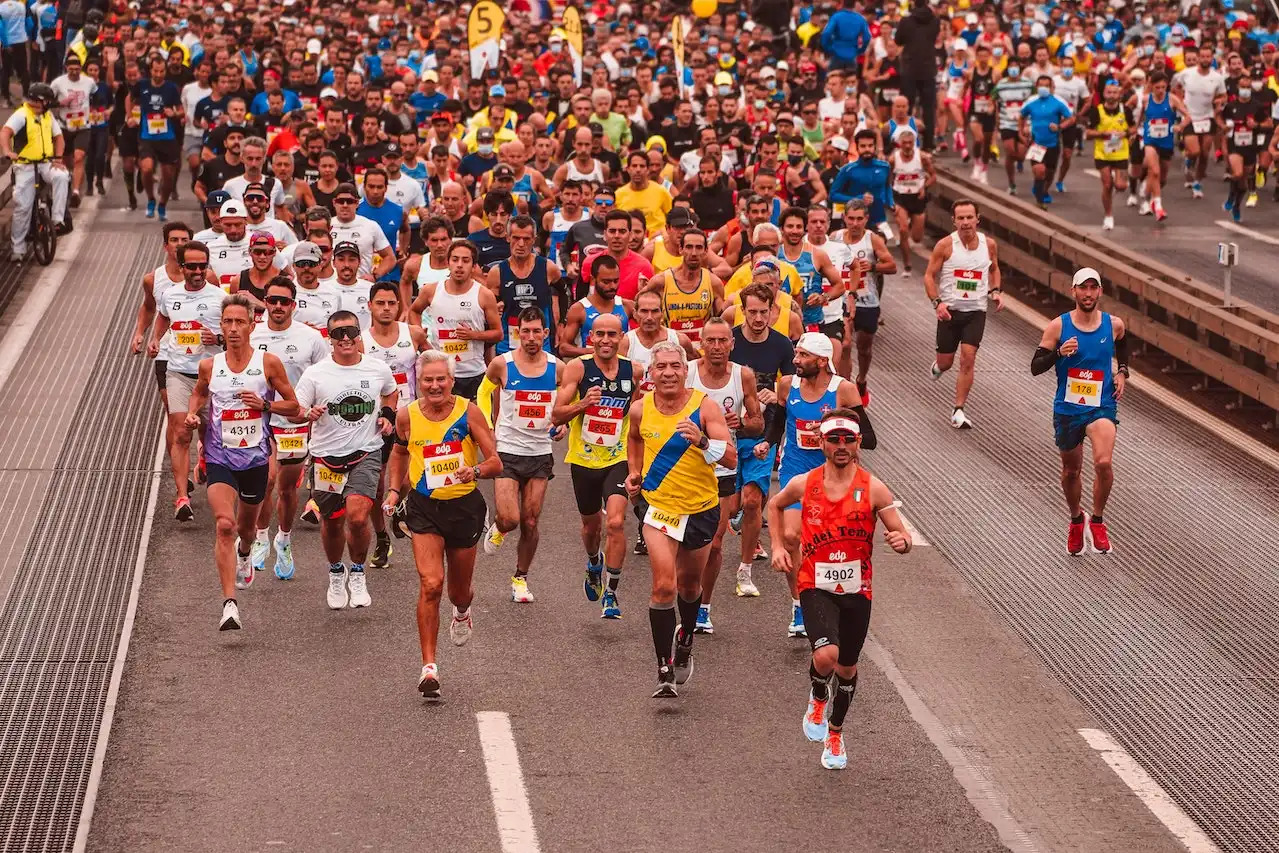

Featured
What Is A Marathon
Modified: January 22, 2024
Discover what a marathon is and how you can become a featured participant in this challenging and rewarding endurance event.
Introduction
Marathons are more than just a test of physical endurance; they are a celebration of the indomitable human spirit and a showcase of sheer determination. Every year, thousands of runners lace up their shoes and take to the streets, pushing themselves to their limits and cheering each other on. Whether you are a seasoned runner or just starting out, participating in a marathon is an incredible experience that can be both challenging and fulfilling.
A marathon is a long-distance race with a total length of 26.2 miles or 42.195 kilometers. It is one of the ultimate tests of an athlete’s strength, endurance, and mental fortitude. The race takes its name from the legend of the Greek messenger Pheidippides, who ran from the city of Marathon to Athens to deliver news of the Greek victory over the Persians. According to the legend, Pheidippides completed the distance and then collapsed and died from exhaustion.
The modern marathon as we know it today has evolved significantly from its humble origins. It is now a well-organized event that attracts participants and spectators from all over the world. From the iconic Boston Marathon in the United States to the Comrades Marathon in South Africa and the Tokyo Marathon in Japan, marathons have become an integral part of the global sporting calendar.
Running a marathon is not just about the physical training; it also requires mental strength and discipline. The journey from the starting line to the finish line is filled with challenges, both physical and mental. It is a test of perseverance and resilience, pushing runners to dig deep and find the strength to keep going when their bodies want to quit.
In this article, we will delve into the world of marathons, exploring their history, the mental and physical challenges they present, and the benefits of participating in these epic races. Whether you are a current or aspiring marathoner or just curious about this incredible feat of human endurance, this article aims to provide you with valuable insights and guidance.
Definition of a Marathon
A marathon is a long-distance race that covers a total distance of 26.2 miles or 42.195 kilometers. It is one of the most iconic and challenging events in the world of sports. The marathon distance has become the standard for endurance running, representing the ultimate test of physical and mental strength.
The term “marathon” originated from the legend of the Greek messenger Pheidippides. According to the story, during the Battle of Marathon in 490 BC, Pheidippides was sent to Athens to deliver news of the Greek victory over the Persians. After running the entire distance without stopping, he arrived in Athens, proclaimed, “We have won!”, and then collapsed and died from exhaustion.
The marathon as an organized event has evolved over the centuries. The first organized marathon in modern history took place during the inaugural modern Olympic Games in Athens in 1896. The route traced the path from the city of Marathon to the Olympic Stadium in Athens, paying homage to Pheidippides’ legendary run.
Since then, marathons have gained immense popularity around the world, attracting professional athletes, casual runners, and even walkers. The sport has become more inclusive, with various categories such as wheelchair races and age-group categories, allowing people of all abilities to participate.
Marathons are typically held on roads or a combination of roads and trails, and they usually follow a predetermined course with clearly marked mile markers. The courses often traverse iconic landmarks and offer breathtaking scenery, adding to the allure and appeal of participating in a marathon.
Completing a marathon requires months of training and preparation. Runners must build up their endurance, stamina, and speed through a structured training program that includes long runs, interval training, tempo runs, and cross-training. It is crucial for runners to gradually increase their mileage to prevent injuries and allow their bodies to adapt to the demands of the race.
The average time to complete a marathon varies greatly depending on factors such as age, fitness level, and experience. Elite runners can finish in under two and a half hours, while recreational runners may take between four to six hours. However, the primary goal for most marathon participants is simply to cross the finish line and achieve a personal sense of accomplishment.
Marathons are not just about individual achievement; they also foster a sense of camaraderie and community. The support and encouragement from fellow runners, volunteers, and spectators can make a significant difference in the overall experience. Marathons often bring diverse groups of people together, creating a vibrant and inclusive atmosphere that epitomizes the spirit of sportsmanship.
In the next sections of this article, we will delve deeper into the history of marathons, explore the physical and mental challenges they present, and provide tips for running your first marathon.
Origin and History of Marathons
The origin of marathons can be traced back to ancient Greece, specifically to the legend of the Greek messenger Pheidippides. According to historical accounts, during the Battle of Marathon in 490 BC, the Athenians defeated the invading Persians. Pheidippides, a trained runner, was chosen to deliver the news of the victory to Athens, located approximately 25 miles away.
Legend has it that Pheidippides ran the entire distance without stopping, reaching Athens to announce the Greek victory with the famous words “We have won!” and then collapsing and dying from exhaustion. The distance he covered became the inspiration for the modern marathon and the race we know today.
The first organized marathon in modern history took place in the 1896 Summer Olympics held in Athens, Greece. Inspired by the legend of Pheidippides, the marathon was included as a tribute to the ancient Greek sporting tradition. The race covered the distance from the city of Marathon to the Olympic Stadium in Athens, totaling approximately 26.2 miles.
The event gained international attention when Greek runner Spyridon Louis won the marathon, becoming the first Olympic marathon champion. The marathon grew in popularity from that point forward, with other countries including it as a prominent event in their respective Olympic Games.
One of the most significant milestones in the marathon’s history came in 1908 at the London Olympics. The race was initially planned to cover a distance of 26 miles, but the course was lengthened to allow the race to start at Windsor Castle, where the royal family could view the start. This extension added an additional 385 yards to the race, bringing the total distance to 26.2 miles. This new distance was then established as the official marathon distance.
The Boston Marathon, first held in 1897, is one of the oldest and most prestigious marathons in the world. It holds a special place in the history of marathons as the world’s oldest annual marathon. The race was inspired by the marathon event in the first modern Olympic Games and has since become one of the most iconic marathons, attracting elite athletes from around the globe.
In recent years, marathons have evolved to embrace inclusivity and diversity. Wheelchair races were introduced in the Boston Marathon in 1975, and now many marathons include divisions for different age groups, as well as races specifically for women, amateur runners, and relay teams. This inclusivity has expanded the reach and appeal of marathons, making the event accessible to a wider range of participants.
The history of marathons is full of remarkable stories of triumph, determination, and endurance. From the legend of Pheidippides to the modern-day marathons that capture the world’s attention, these races continue to inspire individuals to push their limits and challenge themselves both physically and mentally.
In the following sections, we will explore the famous marathons around the world, delve into the training required to prepare for a marathon, and discuss the mental and physical challenges that participants face during these demanding races.
Famous Marathons around the World
Marathons have gained worldwide popularity and have become iconic events in the sporting world. From the historic and prestigious races to the scenic and challenging courses, here are some of the famous marathons held around the world:
- Boston Marathon: Known as the oldest annual marathon, the Boston Marathon has been held since 1897. It attracts elite runners from all over the world and requires participants to meet strict qualifying standards. The race follows a challenging course that includes the infamous Heartbreak Hill.
- New York City Marathon: Held annually since 1970, the New York City Marathon is one of the most popular and highly sought-after marathons. It takes runners through the five boroughs of New York City, showcasing famous landmarks such as the Statue of Liberty and Central Park.
- Berlin Marathon: Known for its flat and fast course, the Berlin Marathon is the race where numerous world records have been set. Runners from around the world flock to Berlin every year to experience the electric atmosphere and have a chance to achieve their personal best.
- London Marathon: With its royal starting line at Greenwich, the London Marathon offers a scenic route that takes participants past iconic landmarks like Tower Bridge, Big Ben, and Buckingham Palace. It is one of the largest marathons globally and incorporates a unique charity element.
- Tokyo Marathon: The Tokyo Marathon has grown in popularity over the years and attracts both local and international runners. The course showcases the cultural and historical landmarks of Tokyo, providing a unique blend of tradition and modernity.
- Chicago Marathon: Known for its flat and fast course, the Chicago Marathon is a favorite among beginner and seasoned runners alike. The race takes participants through the vibrant streets of downtown Chicago, treating them to stunning architecture and lively crowds.
- Paris Marathon: The Paris Marathon offers a picturesque route that takes participants past famous landmarks such as the Eiffel Tower, Notre Dame, and the Louvre. It attracts runners from all over the world who come to experience the beauty and history of the city while conquering the 26.2-mile course.
- Boston Marathon: Known as the oldest annual marathon, the Boston Marathon has been held since 1897. It attracts elite runners from all over the world and requires participants to meet strict qualifying standards. The race follows a challenging course that includes the infamous Heartbreak Hill.
- New York City Marathon: Held annually since 1970, the New York City Marathon is one of the most popular and highly sought-after marathons. It takes runners through the five boroughs of New York City, showcasing famous landmarks such as the Statue of Liberty and Central Park.
- Berlin Marathon: Known for its flat and fast course, the Berlin Marathon is the race where numerous world records have been set. Runners from around the world flock to Berlin every year to experience the electric atmosphere and have a chance to achieve their personal best.
- London Marathon: With its royal starting line at Greenwich, the London Marathon offers a scenic route that takes participants past iconic landmarks like Tower Bridge, Big Ben, and Buckingham Palace. It is one of the largest marathons globally and incorporates a unique charity element.
- Tokyo Marathon: The Tokyo Marathon has grown in popularity over the years and attracts both local and international runners. The course showcases the cultural and historical landmarks of Tokyo, providing a unique blend of tradition and modernity.
- Chicago Marathon: Known for its flat and fast course, the Chicago Marathon is a favorite among beginner and seasoned runners alike. The race takes participants through the vibrant streets of downtown Chicago, treating them to stunning architecture and lively crowds.
- Paris Marathon: The Paris Marathon offers a picturesque route that takes participants past famous landmarks such as the Eiffel Tower, Notre Dame, and the Louvre. It attracts runners from all over the world who come to experience the beauty and history of the city while conquering the 26.2-mile course.
These are just a few of the many noteworthy marathons held worldwide. Each marathon offers a unique experience, challenging runners with its course and providing a glimpse into the culture and beauty of its host city. Whether you are a seasoned marathoner or dreaming of your first race, participating in one of these famous marathons is a goal that can inspire and motivate you to achieve new heights in your running journey.
Training for a Marathon
Preparing for a marathon requires months of dedicated training and careful planning. It is essential to gradually build up your endurance, improve your strength, and develop a training routine that suits your individual needs and goals.
The following are some key aspects of training for a marathon:
- Mileage buildup: Start by gradually increasing your weekly mileage, allowing your body to adapt to the demands of running long distances. Begin with shorter runs and slowly work your way up to longer runs, incorporating both easy-paced runs and a long run each week.
- Long runs: Long runs are crucial for building endurance and simulating the distance of a marathon. Gradually increase the distance of your long run each week, aiming to reach at least 20 miles a few weeks before the race. Practice fueling and hydration strategies during these long runs to prepare for race day.
- Speed work: Include tempo runs, intervals, and fartlek training to improve your speed and race pace. These workouts help increase your cardiovascular fitness, improve your running economy, and enhance your ability to sustain a faster pace over long distances.
- Cross-training: Supplement your running with activities like cycling, swimming, or strength training to improve overall fitness, prevent overuse injuries, and give your body a break from the high-impact stresses of running.
- Rest and recovery: Allow ample time for rest and recovery between training sessions. Listen to your body and take rest days when needed to prevent injuries and avoid burnout. Incorporate recovery methods such as foam rolling, stretching, and getting enough sleep to aid in muscle repair and regeneration.
- Consistency: Consistency is key when training for a marathon. Stick to a structured training plan and remain committed to your workouts. Building a solid base and maintaining a regular training routine will help you gradually progress and build the necessary endurance for the marathon.
- Tapering: In the weeks leading up to the marathon, gradually reduce your training volume to allow your body to recover and fully prepare for race day. This tapering period helps recharge your energy stores and ensures that you are well-rested and in peak condition for the race.
It is important to note that every runner is different, and what works for one person may not work for another. It’s crucial to listen to your body, adjust your training as needed, and seek guidance from a qualified coach or trainer if necessary. Remember, consistency, patience, and a gradual approach to training are key to a successful marathon journey.
In the next section, we will discuss the mental and physical challenges that runners may encounter during a marathon and provide strategies to overcome them.
The Mental and Physical Challenges of Running a Marathon
Running a marathon is not just a test of physical endurance; it also presents a range of mental and emotional challenges. Understanding and preparing for these challenges is essential to successfully completing the race. Here are some of the common mental and physical hurdles that marathon runners may face:
Physical Fatigue: The physical demands of running 26.2 miles can lead to fatigue and discomfort. As the miles accumulate, muscles may start to ache, blisters may appear, and overall exhaustion may set in. However, recognizing that fatigue is a natural part of the process can help you push through the physical discomfort.
Mental Fatigue: Endurance running requires mental strength and determination. As the race progresses, you may experience mental fatigue and doubt your ability to finish. Keeping a positive mindset, breaking the race into smaller segments, and focusing on each mile can help combat mental fatigue.
Weather Conditions: Extreme weather conditions such as heat, humidity, or cold can add an additional layer of difficulty to a marathon. Proper preparation, hydration, and adjusting your pace to the weather conditions can help you overcome these challenges.
Hydration and Nutrition: Maintaining proper hydration and fueling throughout the race is essential. Dehydration and inadequate nutrition can lead to cramping, fatigue, and diminished performance. Developing a race-day nutrition plan and practicing it during training can help avoid these issues.
Pace Management: Finding the right pace and sticking to it can be challenging during a marathon. Starting too fast can lead to early exhaustion, while starting too slow may prevent you from reaching your full potential. Training with a GPS watch or running with a pace group can help you maintain a consistent pace.
Wall or “Hitting the Wall”: The phenomenon commonly known as “hitting the wall” typically occurs during the later stages of a marathon, around mile 20 or beyond. It is a sudden loss of energy and can make the remaining miles extremely difficult. Proper nutrition, pacing, mental preparation, and training for the longer distances can help you navigate through this challenging phase.
Self-Doubt and Mental Resilience: Marathon running requires mental resilience. Doubts may creep in, telling you to give up or doubt your ability to finish. Cultivating a strong mental mindset, positive self-talk, and drawing upon your training and past accomplishments can help you overcome these moments of self-doubt.
Embracing the Unknown: No two marathons are the same. There are countless variables such as route elevation, weather conditions, and race-day surprises that can make each race unique. Preparing mentally to adapt and embrace the unknown can provide a sense of flexibility and resilience.
Overcoming these mental and physical challenges requires a combination of physical training, mental preparation, and a positive mindset. It is important to remember that every challenge presents an opportunity for growth and that the journey towards the finish line is just as important as crossing it.
In the next section, we will provide valuable tips for those who are preparing to run their first marathon, equipping them with the knowledge and strategies to have a successful and enjoyable race.
Tips for Running Your First Marathon
Running a marathon is a monumental achievement, and preparing for your first marathon requires careful planning and dedication. Whether you are an experienced runner tackling the distance for the first time or a novice runner embarking on a new challenge, here are some valuable tips to help you have a successful and enjoyable race:
- Set Realistic Goals: Be realistic about your expectations and set achievable goals for your first marathon. Focus on finishing strong and enjoying the experience rather than aiming for a specific time.
- Follow a Training Plan: Stick to a structured training plan that gradually increases your mileage and incorporates long runs, tempo runs, and speed workouts. A training plan will help build endurance, improve your fitness, and minimize the risk of injury.
- Build a Base: Prior to starting marathon training, build a solid running base by gradually increasing your weekly mileage. This will help your body adapt to the demands of marathon training and reduce the risk of overuse injuries.
- Get Proper Gear: Invest in a good pair of running shoes that provide the necessary support and cushioning for your feet. Additionally, consider wearing moisture-wicking clothing to keep you comfortable and prevent chafing.
- Practice Proper Nutrition: Fuel your body with a balanced diet that includes carbohydrates for energy, lean proteins for muscle repair, and healthy fats for overall health. Experiment with different foods and hydration strategies during training to find what works best for you on race day.
- Hydrate Well: Proper hydration is crucial for marathon success. Drink water regularly throughout the day and consider carrying fluids or taking advantage of aid stations during the race. Avoid trying new drinks or foods on race day to prevent stomach discomfort.
- Respect Rest and Recovery: Allow for adequate rest days in your training schedule and prioritize sleep to allow your body to recover and adapt to the training load. Incorporate restorative activities such as stretching, foam rolling, and massages to aid in recovery.
- Listen to Your Body: Pay attention to any signs of injury or overtraining, and do not hesitate to take a break or seek medical advice when needed. Pushing through pain can lead to more severe injuries and hinder your progress.
- Visualize Success: Use visualization techniques to mentally prepare for the race. Imagine yourself crossing the finish line strong and visualize the race going smoothly. This positive mindset can help boost your confidence and motivation.
- Enjoy the Experience: Remember that your first marathon is a significant accomplishment. Embrace the journey and enjoy the process. Take in the sights, soak up the atmosphere, and celebrate each milestone along the way.
Remember, running a marathon is as much a mental challenge as it is a physical one. Trust in your training, stay positive, and believe in yourself. Crossing that finish line after months of hard work and dedication is an experience like no other.
In the next section, we will explore the various benefits of participating in marathons and how they can positively impact your physical and mental well-being.
Benefits of Participating in Marathons
Participating in a marathon offers more than just the accomplishment of completing the distance. It has numerous physical, mental, and emotional benefits that can positively impact your overall well-being. Here are some of the key benefits of participating in marathons:
- Physical Fitness: Training for and running a marathon is a fantastic way to improve your physical fitness. It enhances cardiovascular health, strengthens muscles and bones, and boosts overall endurance and stamina. Regular marathon training can lead to weight loss, improved body composition, and increased energy levels.
- Mental Resilience: Running a marathon requires mental strength and resilience. The discipline and determination developed throughout the training process can translate into other areas of life, helping you overcome challenges and achieve goals beyond running.
- Stress Relief: Engaging in regular exercise, such as marathon training, releases endorphins, which are known as the “feel-good” hormones. Completing a marathon can provide a sense of accomplishment and serve as a natural stress reliever, promoting mental well-being.
- Goal Setting and Achievement: Training for and completing a marathon involves setting specific goals, following a training plan, and committing to the process. Crossing the finish line is a tangible achievement that boosts confidence, self-esteem, and a sense of accomplishment.
- Social Connections: Participating in a marathon brings together individuals with a shared interest in running and fitness. It provides an opportunity to connect with like-minded people, share experiences, and build a supportive community of fellow runners.
- Increased Mental Clarity: Regular physical activity, including marathon training, has been shown to improve cognitive function and enhance mental clarity. It can sharpen focus, boost creativity, and increase productivity, leading to overall mental well-being.
- Charitable Opportunities: Many marathons are associated with charitable causes. Participating in a marathon allows you to contribute to and support these organizations, making a positive impact on the lives of others and giving back to the community.
- Personal Growth and Personal Records: Running a marathon pushes you to go beyond your comfort zone and reach new personal limits. Each training run and race experience provides valuable lessons in perseverance, determination, and self-improvement.
- Improved Overall Health: Regular marathon training promotes a healthy lifestyle. It encourages mindful eating, adequate hydration, and creates a routine that prioritizes sleep, all of which contribute to improved overall health and well-being.
- Inspiration and Motivation: Engaging in marathon training and witnessing the achievements of fellow runners can be inspiring and motivating. It encourages you to push your boundaries, set new goals, and continue pursuing personal growth both on and off the race course.
Participating in a marathon is not just about the race day experience; it is a transformative journey that offers numerous benefits for your physical, mental, and emotional well-being. Whether you are a veteran marathoner or embarking on your first race, the impact of participating in marathons extends far beyond the finish line.
In the next section, we will explore the etiquette and rules that every marathon participant should be aware of to ensure a smooth and enjoyable race for all.
Marathon Etiquette and Rules
Participating in a marathon not only requires physical and mental preparation but also adherence to certain etiquette and rules to ensure the safety and enjoyment of all participants. Here are some key guidelines to keep in mind:
- Know the Course: Familiarize yourself with the marathon course in advance. Study the map, elevation changes, aid station locations, and any specific instructions or landmarks along the route.
- Start Line Etiquette: Arrive at the start line on time, allowing yourself enough time to warm up and find your assigned corral. Follow the instructions of race officials and line up in the appropriate pace group to ensure a smooth and organized start.
- Respect Other Participants: Be mindful of your fellow runners. Avoid blocking others or abruptly changing direction. If you need to stop or walk, move to the side of the course to allow others to pass freely.
- Follow Aid Station Protocol: When approaching aid stations, move to the side of the course to grab water or nutrition. Dispose of cups in designated bins or drop zones to avoid creating hazards for other runners.
- Be Mindful of Litter: Do not litter on the course. Dispose of any gel packets, wrappers, or other waste in designated bins or carry them until you reach an appropriate disposal area.
- Be Courteous to Spectators: Show appreciation for the support of spectators along the course by acknowledging their cheers and thanking them. However, avoid excessive interaction that may disrupt your pace or the flow of the race.
- Use Headphones Responsibly: If you choose to listen to music during the race, keep the volume low enough to hear instructions from race officials and the sounds of the environment for safety purposes.
- Respect Race Officials and Volunteers: Follow the instructions of race officials, volunteers, and course marshals at all times. They are there to ensure the safety and smooth operation of the race.
- Encourage and Support Others: Offer words of encouragement to fellow runners, especially when they appear fatigued or struggling. A simple act of kindness can make a significant difference in another participant’s experience.
- Finish Line Etiquette: Cross the finish line and keep moving to allow space for other runners behind you. Follow the instructions of race officials, collect your medal, and celebrate your accomplishment without obstructing the flow of other participants.
It is important to familiarize yourself with the specific rules and regulations of the marathon you are participating in, as each event may have additional guidelines tailored to their course and logistics. Adhering to these guidelines and showing respect for fellow participants, volunteers, and race officials will ensure a safe and enjoyable race experience for everyone involved.
Now that you are equipped with the knowledge of marathon etiquette and rules, you are ready to embark on your marathon journey with confidence and consideration for others!
Conclusion
Participating in a marathon is an extraordinary achievement that requires dedication, perseverance, and a strong belief in oneself. The journey from training to crossing the finish line is filled with physical challenges, mental obstacles, and unforgettable moments of triumph.
Throughout this article, we explored the definition and history of marathons, learned about famous races around the world, discussed the training process, and highlighted the mental and physical challenges that runners may encounter. We also provided valuable tips for those preparing for their first marathon, discussed the benefits of participating in marathons, and outlined important etiquette and rules for a smooth and enjoyable race experience.
Running a marathon is a transformative experience that goes beyond physical fitness and achievement. It pushes boundaries, builds mental resilience, fosters personal growth, and cultivates a sense of community among fellow runners. The dedication and discipline required to train for and complete a marathon instill qualities that can positively impact other areas of life.
Whether you are a seasoned marathoner or aspiring to run your first race, embrace the journey with passion and determination. Cherish the moments on the course, the camaraderie with other runners, and the support of spectators. Remember that the finish line is not just a destination; it represents the culmination of countless hours of hard work and a testament to the strength of the human spirit.
So, lace up your running shoes, set your goals, and embark on the incredible journey of running a marathon. May the road ahead be filled with personal triumphs, newfound friendships, and a deep appreciation for the remarkable feat of completing a marathon. The marathon awaits, and you are more than capable of conquering it.
